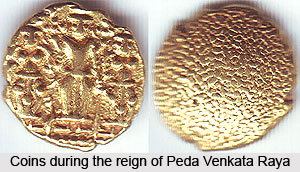 Peda Venkata Raya or Venkata III was the ruler of Vijayanagara Empire who ruled this area from the year 1632 till 1642. He was the grandson of Aliya Rama Raya, the regent of Achyuta Rama Raya and Venkata I.
Peda Venkata Raya or Venkata III was the ruler of Vijayanagara Empire who ruled this area from the year 1632 till 1642. He was the grandson of Aliya Rama Raya, the regent of Achyuta Rama Raya and Venkata I.
Seizure by Timma Raja
Timma Raja, the paternal uncles of Venkata III and a brother of Sriranga II captured Vellore Fort, thereby compelling Venkata III to continue residing at Anekonda, which was his home. However, the Nayaks of Madurai, Tanjore and Ginjee proclaimed their cooperation with Venkata III. Timma Raja was viewed at as an imposter and was supported by none. Despite his defeat, Timma Raja hatched some mischievous plans and therefore till his death in 1635, the rule of Venkata III was interspersed with violence and civil strife. Sriranga III, one of the nephews of Venkata III defeated Timma Raja, thanks to the assistance of the Dutch in the area of Pulicat. Thus, Timma Raja was left with no other alternative but to accept and acknowledge the supremacy of Venkata III. Timma Raja was permitted to govern some territories and was assassinated in the year 1635. Lastly, peace prevailed and Venkata III went back to Vellore.
Francis Day, of the East India Company received some portion of land in the Coromandel Coast from the king Venkata III, in the area of Chandragiri on 22nd August 1639, for the purpose of creating a factory for conducting trade. Damerla Venkatadri Nayakudu, who was a Recherla Velama chieftain of Vandavasi and Srikalahasti was controlling the region at that point of time. Damerla Chennappa Nayakudu`s son was Venkatadri Nayakudu. During 1637, the Nayaks of Madurai and Tanjore tried to defeat Venkata III and invade Vellore but they lost to Venkata III and entered into a peace agreement.
Rebellion of Sriranga III
In 1638, Sriranga III, who was the nephew of Venkata III revolted against Venkata III and plotted an invasion from the region of Bijapur. He made the then ruler of Bijapur his ally against Venkata III and their attack on Bangalore proved quite expensive for Venkata III since peace was bought only after a costly deal. Supported by the then king of Bijapur, Sriranga III again launched an attack against the forces of Venkata III. However, the Southern Nayaks made it impossible for the invaders to succeed in their plans. They were at a distance on about 12 miles from the Vellore fort.
During the year 1641, the Sultan of Golconda ordered his army to proceed along the East Coast. His army, however, was resisted by the army of Venkata III when they approached Madras. They army of Venkata III was supported by Gingee Nayak and Damerla Venkatadri Nayaka. Defeated, the Golconda army started marching towards Vellore fort. However, Venkata III felt threatened due to pressures from the armies of all the sides and escaped to the jungles of Chittoor. He died in October 1642. As he did not possess a son, he was succeeded by Sriranga III.



















